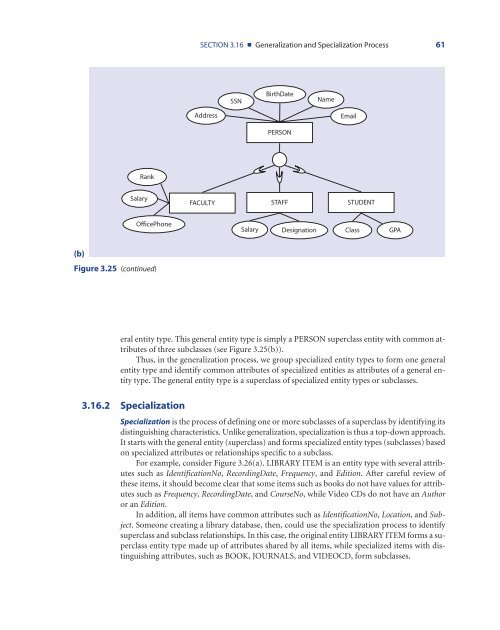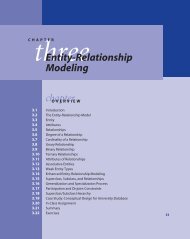Web-DSS-Chapter-03
Web-DSS-Chapter-03
Web-DSS-Chapter-03
- No tags were found...
You also want an ePaper? Increase the reach of your titles
YUMPU automatically turns print PDFs into web optimized ePapers that Google loves.
SECTION 3.16 ■ Generalization and Specialization Process 61SSNBirthDateNameAddressEmailPERSONRankSalaryFACULTY STAFF STUDENTOfficePhoneSalaryDesignationClassGPA(b)Figure 3.25 (continued)eral entity type. This general entity type is simply a PERSON superclass entity with common attributesof three subclasses (see Figure 3.25(b)).Thus, in the generalization process, we group specialized entity types to form one generalentity type and identify common attributes of specialized entities as attributes of a general entitytype. The general entity type is a superclass of specialized entity types or subclasses.3.16.2 SpecializationSpecialization is the process of defining one or more subclasses of a superclass by identifying itsdistinguishing characteristics. Unlike generalization, specialization is thus a top-down approach.It starts with the general entity (superclass) and forms specialized entity types (subclasses) basedon specialized attributes or relationships specific to a subclass.For example, consider Figure 3.26(a). LIBRARY ITEM is an entity type with several attributessuch as IdentificationNo, RecordingDate, Frequency, and Edition. After careful review ofthese items, it should become clear that some items such as books do not have values for attributessuch as Frequency, RecordingDate, and CourseNo, while Video CDs do not have an Authoror an Edition.In addition, all items have common attributes such as IdentificationNo, Location, and Subject.Someone creating a library database, then, could use the specialization process to identifysuperclass and subclass relationships. In this case, the original entity LIBRARY ITEM forms a superclassentity type made up of attributes shared by all items, while specialized items with distinguishingattributes, such as BOOK, JOURNALS, and VIDEOCD, form subclasses.



